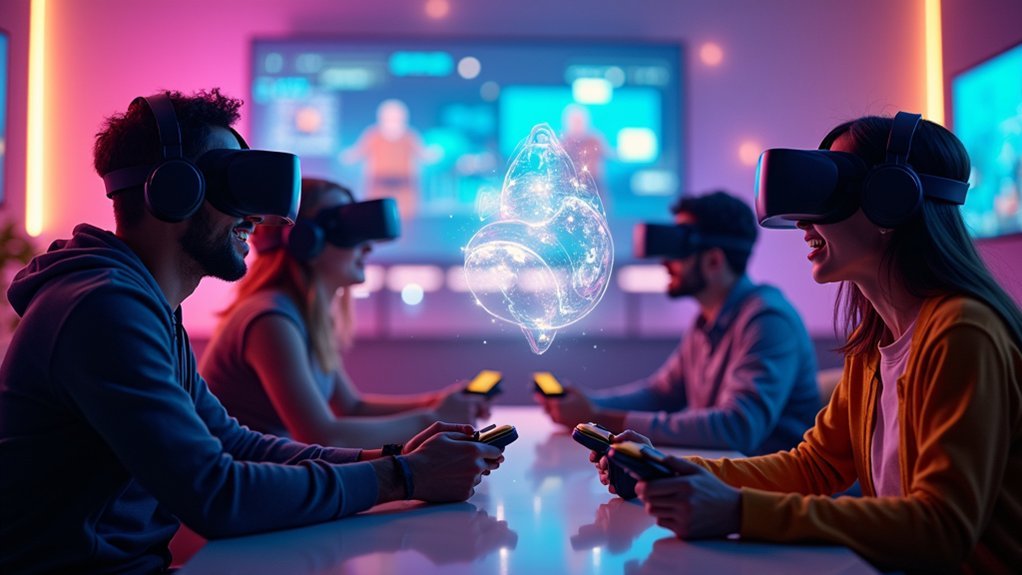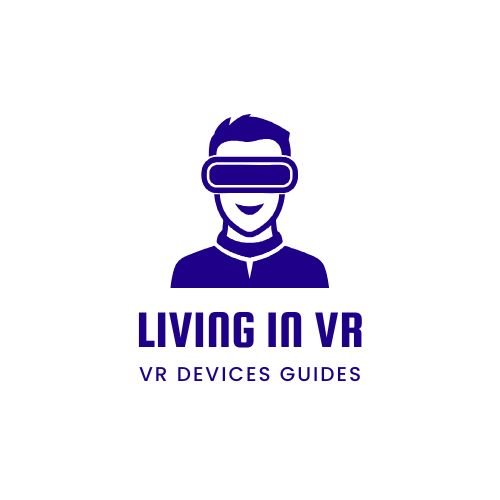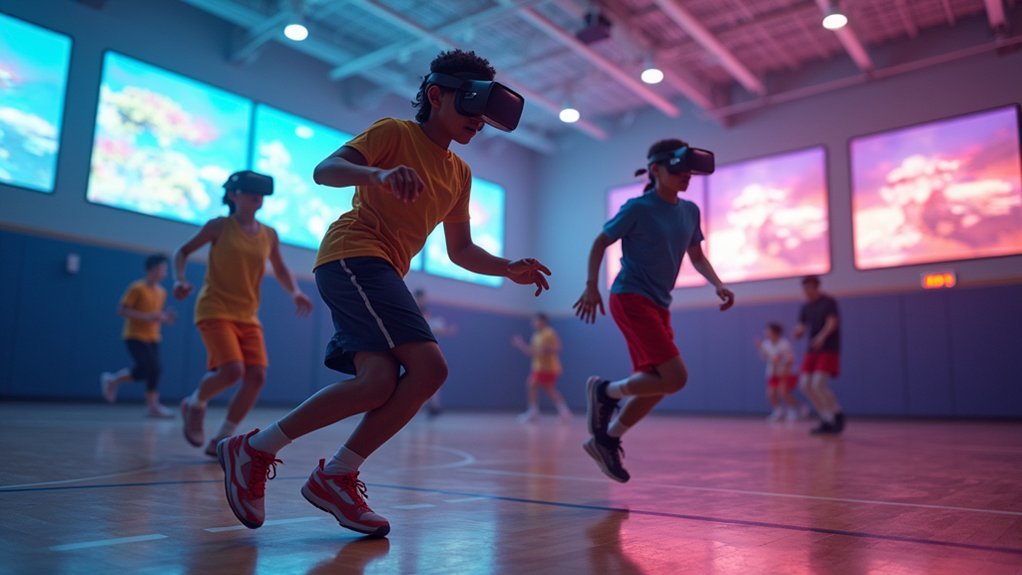You’ll need to choose a robust VR development engine like Unity or Unreal, design dedicated server architecture with cloud infrastructure, and implement real-time object synchronization using libraries like Photon. Optimize avatar tracking systems, configure spatial audio with platforms like Vivox, and create responsive UI designs that work across all devices. Set up scalable servers, conduct thorough performance testing across VR hardware, and deploy security measures with anti-cheat protection. These foundational steps reveal the complete framework for seamless cross-platform VR experiences.
Choose the Right Cross-Platform VR Development Engine

When building cross-platform multiplayer VR games, you’ll need to select a development engine that supports multiple platforms and provides robust VR capabilities.
Unity stands out as an excellent choice, supporting over 25 platforms with extensive VR tools and thousands of assets in its Asset Store. You can leverage these resources to enhance your project without starting from scratch.
Alternatively, Unreal Engine offers high-fidelity graphics and Blueprint visual scripting for rapid development, making it ideal for creating realistic, immersive environments.
Both engines support essential VR hardware like Oculus Rift, HTC Vive, and PlayStation VR, ensuring broad compatibility.
Their optimization tools, including Unity’s Profiler and Unreal’s performance analysis features, help you manage frame rates and deliver smooth gameplay across various devices.
Design a Unified Network Architecture for VR Multiplayer
Once you’ve chosen your development engine, you’ll need to architect a network system that handles VR’s unique demands for real-time synchronization and low latency.
Adopt a dedicated server model to manage player interactions and maintain consistent game states across all devices. Implement reliable networking libraries like Photon or Unity Networking to streamline communication between VR clients and guarantee seamless data transmission.
Deploy robust server infrastructure using cloud-based solutions such as AWS or Microsoft Azure to handle simultaneous users and scale with fluctuating player counts.
Incorporate state interpolation and reconciliation techniques to compensate for network latency variations. Focus on continuous performance optimization through rigorous testing across different VR platforms, identifying synchronization issues early to enhance overall gameplay quality.
Implement Real-Time Object Synchronization Across VR Platforms

After establishing your unified network architecture, you’ll need to tackle the complex challenge of synchronizing objects in real-time across different VR platforms.
Real-time object synchronization demands a robust networking system that minimizes latency while maintaining consistent gameplay across devices. You’ll want to implement state interpolation and reconciliation techniques to smooth out position discrepancies and guarantee seamless interactions.
Advanced networking libraries like Photon and Unity’s Netcode provide essential tools for managing player movements and object tracking effectively.
Since VR platforms have varying hardware capabilities, you must optimize your synchronization algorithms for performance stability across diverse devices and internet conditions.
Regular testing is significant—42% of players cite performance issues as major VR gaming concerns, making flawless synchronization critical for player satisfaction.
Optimize Avatar Movement and Gesture Tracking Systems
You’ll need to master real-time synchronization techniques that keep avatar movements consistent across all connected players, regardless of their platform or device capabilities.
Your input handling systems must adapt to each platform’s unique control methods while maintaining uniform avatar behavior and responsiveness.
You can’t ignore network latency compensation strategies that predict and smooth avatar movements, ensuring fluid interactions even when players experience varying connection delays.
Real-Time Synchronization Techniques
When developing cross-platform multiplayer games, real-time synchronization techniques become the backbone of smooth avatar movement and responsive gesture tracking systems. You’ll need to implement interpolation and extrapolation methods to handle varying network latencies effectively. Client-side prediction provides immediate feedback, reducing perceived lag while advanced reconciliation corrects position discrepancies.
| Technique | Purpose | Benefit |
|---|---|---|
| Interpolation/Extrapolation | Smooth movement prediction | Consistent animations |
| Client-side Prediction | Immediate response | Reduced lag perception |
| State Reconciliation | Error correction | Fair synchronization |
To optimize performance in your multiplayer environment, compress movement data and use efficient serialization methods. Machine learning algorithms can enhance gesture tracking accuracy by predicting player actions. These real-time synchronization techniques guarantee players experience responsive controls regardless of their hardware setup or network conditions.
Platform-Specific Input Handling
Cross-platform multiplayer games demand sophisticated input handling systems that adapt seamlessly to each device’s unique control methods.
You’ll need to implement platform-specific input handling that accommodates touch controls for mobile devices, gamepads for consoles, and keyboard/mouse combinations for PCs. Gesture tracking systems prove particularly valuable for mobile platforms, with 75% of users preferring gesture-based navigation and gameplay interactions.
You should utilize input abstraction layers to streamline integration across different input methods, guaranteeing avatar movement remains fluid and responsive.
Performance optimization becomes critical here—reducing input latency can make or break fast-paced multiplayer experiences where milliseconds matter. Regular testing across all target devices is essential, as 42% of players abandon games due to control issues.
This all-encompassing approach guarantees you’ll deliver a seamless experience regardless of platform.
Network Latency Compensation
Network latency threatens to undermine even the most sophisticated cross-platform multiplayer experiences, making compensation techniques absolutely critical for maintaining responsive avatar movement and gesture tracking. You’ll need client-side prediction and server reconciliation to minimize perceived lag in multiplayer environments. Implementing interpolation methods creates fluid animations by predicting avatar positions between updates, reducing stutters.
| Technique | Purpose | Impact |
|---|---|---|
| Client-side Prediction | Immediate response | Reduces perceived lag |
| Server Reconciliation | Synchronizes states | Maintains accuracy |
| Interpolation | Smooth animations | Eliminates stutters |
| Lag Compensation | Fair gameplay | Equalizes conditions |
| Real-time Processing | Gesture tracking | Immediate feedback |
Advanced lag compensation algorithms synchronize actions across varying network conditions. Regular optimization testing shows reducing latency by 20ms greatly improves player satisfaction and engagement in your multiplayer games.
Configure Cross-Platform Voice Communication and Spatial Audio
Although setting up multiplayer functionality forms the foundation of cross-platform gaming, you’ll need to implement robust voice communication and spatial audio to create truly immersive player experiences.
Cross-platform multiplayer games require sophisticated networking solutions to handle real-time audio transmission across different devices. You’ll want to leverage middleware solutions that guarantee seamless integration:
- Choose robust networking libraries like Photon or PlayFab for reliable real-time audio transmission.
- Implement spatial audio technology using 3D positioning to enhance competitive gameplay and immersion.
- Integrate middleware solutions such as Dolby.io or Vivox for cross-platform compatibility across game engines.
- Optimize bandwidth and minimize latency to maintain communication quality below 150ms thresholds.
Regular testing across all platforms guarantees consistent audio quality and spatial accuracy, preventing gameplay frustrations that hinder effective player communication.
Establish Consistent Physics and Collision Detection

Physics consistency becomes critical when players across different platforms interact within the same game world, as variations in calculations can lead to unfair advantages or frustrating desynchronization issues.
You’ll need to implement a unified physics engine that handles varying hardware capabilities while maintaining identical interactions across all devices. Optimize collision detection algorithms using bounding volume hierarchies to improve efficiency and accuracy regardless of platform performance levels.
Establish a fixed timestep for physics calculations to prevent discrepancies caused by different frame rates. You should incorporate interpolation and extrapolation techniques to smooth interactions and enhance collision detection accuracy, particularly during high-latency scenarios.
Fixed timestep physics calculations eliminate frame rate inconsistencies while interpolation techniques ensure smooth collision detection during network latency spikes.
Regular testing across all targeted platforms guarantees you’re delivering a consistent experience that maintains player satisfaction and prevents physics-related gameplay disruptions.
Create Platform-Agnostic User Interface and Menu Systems
While maintaining gameplay consistency across platforms requires robust physics systems, creating an intuitive user experience demands equally careful attention to interface design that seamlessly adapts to each device’s unique characteristics.
Your platform-agnostic user interface must embrace responsive design principles to deliver a consistent experience across devices, regardless of screen size or input method.
Essential elements for cross-platform UI development include:
- Flexible grid systems that adapt seamlessly between touch controls and traditional controllers
- WCAG-compliant accessibility standards ensuring proper color contrast and alternative text for all players
- Scalable vector graphics (SVGs) that maintain crisp visuals while reducing asset size and loading times
- Comprehensive user testing across multiple platforms to validate usability expectations
You’ll maximize player satisfaction by prioritizing adaptability over platform-specific customization.
Set Up Scalable Server Infrastructure for VR Sessions
Three critical infrastructure decisions will determine whether your VR multiplayer game delivers seamless experiences or frustrates players with lag and disconnections. First, you’ll need cloud-based platforms like AWS or Azure for scalable server infrastructure that dynamically adjusts to player demand. Second, implement microservices architecture for efficient resource allocation during high-throughput VR sessions. Third, deploy dedicated game servers to minimize latency and guarantee real-time interaction synchronization.
| Infrastructure Component | Primary Benefit |
|---|---|
| Cloud-based servers | Dynamic scaling for ideal performance |
| Microservices architecture | Efficient resource management |
| Dedicated game servers | Reduced latency and improved sync |
| Content Delivery Networks | Faster asset distribution globally |
| Performance monitoring | Proactive bottleneck identification |
Leverage CDNs for global asset distribution and continuously monitor performance metrics to identify bottlenecks before they impact your players’ experiences.
Test Performance Across Different VR Hardware Configurations
After establishing your server infrastructure, you’ll face significant performance variations across VR hardware configurations that can make or break your multiplayer experience.
High-end devices achieve 90+ FPS while lower-tier models struggle to maintain 60 FPS, directly impacting user satisfaction since 40% of VR users report motion sickness from poor performance.
Testing performance across different VR hardware requires these essential steps:
- Use specialized profiling tools like Oculus Performance Profiler or SteamVR Performance Test to measure frame rates, latency, and rendering efficiency.
- Test various environments and scenarios to evaluate how different hardware handles complex multiplayer scenes.
- Implement adaptive quality settings that automatically adjust graphical fidelity based on device capabilities.
- Gather user feedback across multiple headsets to identify specific performance bottlenecks affecting gameplay.
Deploy Security Measures and Anti-Cheat Protection
You’ll need to implement robust authentication systems like OAuth and multi-factor authentication to protect player accounts from unauthorized access.
Encryption protocols such as TLS must be deployed to secure sensitive data transmission and in-game transactions.
Real-time cheat detection systems like FairFight or Easy Anti-Cheat should be integrated to maintain game integrity and prevent cheating behaviors as they occur.
Robust Authentication Systems
When developing cross-platform multiplayer games, you’ll need to prioritize robust authentication systems that serve as your first line of defense against unauthorized access and security breaches.
These systems form the foundation of account security, protecting player data across multiple platforms and devices.
To implement effective authentication measures:
- Deploy OAuth protocols – Enable secure third-party login integration while maintaining user privacy.
- Implement two-factor authentication – Add an extra security layer that greatly reduces unauthorized access attempts.
- Utilize TLS encryption protocols – Secure data transmission to prevent credential interception during login processes.
- Conduct regular security audits – Identify vulnerabilities through penetration testing before malicious actors exploit them.
With 87% of players prioritizing security features, investing in thorough authentication systems directly impacts user trust and long-term engagement.
Encryption Protocol Implementation
While authentication systems protect your game’s entry points, encryption protocols safeguard the data that flows between players and servers during gameplay.
You’ll want to implement AES encryption to secure sensitive player data and network communications from unauthorized access. This maintains player trust and protects your game’s integrity.
Deploy thorough security measures through regular audits to identify vulnerabilities, as 70% of developers prioritize these protections against data breaches.
You should implement robust anti-cheat protection using server-side validation and integrity checks to prevent cheating behaviors that ruin fair gameplay.
Consider utilizing libraries like Photon or PlayFab for real-time communication encryption and session management.
Continuously monitor and update your protocols, since 60% of gamers express strong concerns about cheating and data security.
Real-Time Cheat Detection
Building upon your encryption foundation, real-time cheat detection systems form the active defense layer that monitors gameplay as it happens.
These middleware solutions like BattlEye or Easy Anti-Cheat can reduce cheating incidents by over 90% in multiplayer games, maintaining competitive balance across all platforms.
Your anti-cheat strategy should incorporate multiple detection layers for enhancing game integrity:
- Client-server validation – Cross-reference player actions between client and server to identify suspicious discrepancies.
- Machine learning algorithms – Adapt detection patterns to evolving cheating techniques automatically.
- Player reporting integration – Combine automated detection with community flagging for improved accuracy.
- Regular security audits – Conduct penetration testing every six months to uncover vulnerabilities.
This thorough approach guarantees fair play while protecting your cross-platform gaming environment from sophisticated cheat attempts.
Frequently Asked Questions
How Does Cross-Platform Multiplayer Work?
You’ll connect through unified servers that synchronize game states across different devices. Your PC, console, or mobile device communicates via real-time protocols, ensuring you’re playing the same game simultaneously with consistent experiences.
How Do You Play It Takes Two With a Friend Cross-Platform?
You’ll install “It Takes Two” on your platforms, then use the Friend’s Pass feature to invite your friend for free. Create a party through the in-game interface and send cross-platform invites.
How to Join Crossplay Game?
You’ll need to enable crossplay in your game’s multiplayer settings, guarantee your account’s linked correctly across platforms, verify the game supports crossplay, and use the invite system to join friends.
Is It Difficult to Make Games Cross-Platform?
Yes, you’ll face significant challenges making cross-platform games. You’ll need expertise in network programming, server infrastructure, and platform-specific optimizations. You’ll also require extensive testing since performance issues cause 42% of player dissatisfaction.





Leave a Reply